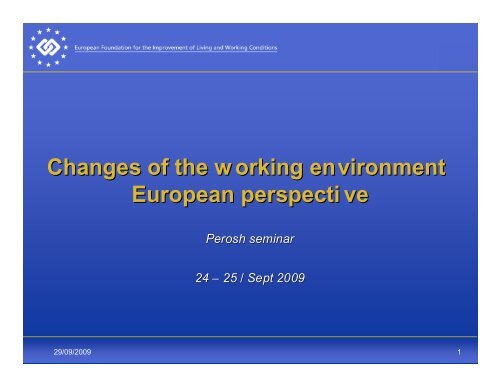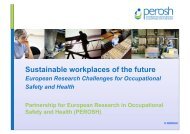slider - perosh
slider - perosh
slider - perosh
Create successful ePaper yourself
Turn your PDF publications into a flip-book with our unique Google optimized e-Paper software.
Changes of the w orking environment<br />
European perspecti ve<br />
Perosh seminar<br />
24 25 / Sept 2009<br />
29/09/2009<br />
1
Main characteristics of the EWCS<br />
• 4 so far, 5th ewcs fieldwork to start in January 2010<br />
• 15+ in employment according to LFS standards<br />
• Face to face interviews of around 35 minutes<br />
• From 1991 to 2005: questionnaire has expanded from 30 to 100 questions <br />
however attempt to keep trends and survey has expanded its geographical<br />
scope from 12 countries to probably 34 in 2010<br />
• Revision of questionnaire with the support of an expert questionnaire<br />
development group<br />
• Strict quality assurance mechanisms<br />
• 4th ewcs :<br />
4 1 questionnaire / 25 languages and 16 variants,<br />
4 31 countries covered : EU27 + ACC2 + NO + SW<br />
4 29680 interviews in total<br />
4 1000 interviews in each country except 600 for CY, EE,<br />
Lxbg, MT and SV<br />
29/09/2009 2
The context<br />
• The structure of employment has changed :<br />
demographics and economical composition of the<br />
industries<br />
• The economic crisis<br />
4 Some companies are restructuring<br />
4 unemployment is increasing<br />
• The nature of work is changing: more open to<br />
external demands, customers and growing use of<br />
I.T.<br />
29/09/2009 3
the impact on possible changes<br />
• Risks specific to female-dominated jobs<br />
4 Developing gender sensitive analysis<br />
• Diversity of the workforce more diversity in possible impact, acceptable<br />
levels <br />
• Risks linked to new occupations / w org linked to the service industry in<br />
general, the KS in particular<br />
• (un)employment : job insecurityemployment security<br />
• New technologies : surveillance or collaborative work <br />
• Cognitive dimensions of work (risks etc)<br />
• Not a one-best way in work organisation<br />
• Place of work / work around the clock<br />
• Contact / violence with customers and other parties at the workplace<br />
• Collective / isolation <br />
29/09/2009 4
Quality of work and employment<br />
• Ensuring career and employment security<br />
(employment status, income, social protection and<br />
workers rights)<br />
• Maintaining and promoting the health and<br />
wellbeing of workers<br />
• Developing skills and competences (qualifications,<br />
training, learning organisation, career advice)<br />
• Making it possible to reconcile working and nonworking<br />
life<br />
29/09/2009 5
.. The impact on possible changes<br />
• The political debate : employment versus work <br />
• Interrelationships are important : looking at 1 issue in<br />
isolation is not enough (e.g. multi-factorial risk)<br />
• Certain groups / work situations combine exposure to some<br />
risks and the effect of combination is synergetic<br />
• A dynamic perspective is often lacking e.g. penibilité <br />
strenuous- jobs,<br />
29/09/2009 6
Ensuring career and employment<br />
security<br />
• Employment status:<br />
4 non-permanent contracts associated with poorer working conditions.<br />
4 1/2 of the new jobs are not permanent jobs. Most of them are for<br />
non-nationals.<br />
• Workers' rights: vertical and horizontal gender segregation persists;<br />
discrimination<br />
• Income : significant gaps between female and male incomes, low<br />
wages correlated to precarious employment relationships<br />
• Social protection: flexicurity, some new employment forms and<br />
hybrid se /empl- forms are developing and may not covered<br />
against risks<br />
• Undeclared work<br />
29/09/2009 7
Rise in non-standard<br />
employment in the<br />
European Union, 1991 -2005 (%)<br />
20%<br />
18%<br />
16%<br />
14%<br />
12%<br />
10%<br />
8%<br />
6%<br />
4%<br />
2%<br />
0%<br />
Self-employed Part-time Temporary<br />
employment<br />
Second job<br />
1991 (EU12) 1995 (EU15) 2000 (EU15) 2005 (EU25)<br />
29/09/2009 8
Pace of work: demand led...<br />
70%<br />
60%<br />
50%<br />
40%<br />
30%<br />
20%<br />
10%<br />
0%<br />
Direct people's<br />
demands<br />
Work done by<br />
colleagues<br />
Performance<br />
targets<br />
The direct<br />
control of your<br />
boss<br />
The movement<br />
of a machine<br />
1995 EU15 2000 EU15 2005 EU25 2005 EU15 2005 NMS<br />
29/09/2009 9
Promoting health and well-being<br />
• Exposure to traditional risks havent decreased when exposure to<br />
psychosocial risks is increasing<br />
• Motivation, burn out, presenteism<br />
• Emotional demands<br />
• An epidemic of musculoskeletal health problems<br />
• Violence at work<br />
• 10% of workers have been harassed at work<br />
• Mental health a growing concern<br />
• Issues are (high- er ) on the European agenda<br />
• But what we observe across Europe, are the multiplicity of definitions /<br />
concepts and answers to psychosocial risks and mental health issues. We need<br />
to work on developing knowledge and more common understanding ofissues at<br />
stake and solutions to tackle the issues if we want to be able to develop social<br />
compromises<br />
29/09/2009 10
Promoting health and well-being : a<br />
group and dynamic approach<br />
• The older workers:<br />
4 age-related exclusion phenomena,<br />
4 work may result in premature bodily wear and tear<br />
• The female workers:<br />
4 more exposed to violence and harassment,<br />
4 flexible women highly exposed<br />
• The disabled, the chronically ill<br />
(managers)<br />
29/09/2009 11
Exposure to ph ysical risks : stable or on the increase<br />
70<br />
60<br />
50<br />
40<br />
30<br />
20<br />
10<br />
0<br />
Vibrations Noise Low temps Breathing in<br />
smoke, fumes,<br />
dust or<br />
powder<br />
Handling<br />
chemical<br />
products /<br />
substances<br />
Radiation<br />
(welding light<br />
etc)<br />
Painful, tiring<br />
positions<br />
Repetitive<br />
hand or arm<br />
movements<br />
1990 EU12 1995 EU15 2000 EU15 2005 EU25 2005 EU25 2005 OMS 2005 NMS<br />
29/09/2009 12
Bullying / harassment in the workplace<br />
25<br />
20<br />
15<br />
10<br />
5<br />
0<br />
FI<br />
NL<br />
LU<br />
LT<br />
EL<br />
IE<br />
BE<br />
HR<br />
MT<br />
FR<br />
SI<br />
DK<br />
CH<br />
EE<br />
UK<br />
AT<br />
TR<br />
NO<br />
RO<br />
LV<br />
DE<br />
PT<br />
SK<br />
SE<br />
PL<br />
CY<br />
HU<br />
CZ<br />
ES<br />
IT<br />
BG<br />
M<br />
F<br />
29/09/2009 13
Impact of work on health<br />
Impact of work on health, 2005<br />
0% 10% 20% 30% 40% 50% 60%<br />
Work affects health<br />
Reported symptoms:<br />
Backache<br />
Muscular pains<br />
Stress<br />
Fatigue<br />
Headache<br />
Irritability<br />
Anxiety<br />
Hearing<br />
Respiratory<br />
EU15<br />
NMS<br />
29/09/2009 14
Development of skills and competences<br />
• Learning organisations versus lean production<br />
• No increase in access to lifelong learning<br />
• From job (in) security to employment security<br />
• Work intensity on the increase<br />
• subjectivité at the heart of commitment<br />
• Technologies and innovations impact in different<br />
ways<br />
4 Collaborative or surveillance / productivity lead<br />
29/09/2009 15
Increase in work intensity<br />
Does your job involve working at very high speed<br />
0.0% 10.0% 20.0% 30.0% 40.0% 50.0% 60.0% 70.0% 80.0% 90.0% 100.0%<br />
1990<br />
EU12<br />
37.1%<br />
16.8%<br />
12.5%<br />
10.9%<br />
5.0%<br />
10.6%<br />
7.2%<br />
1995<br />
EU15<br />
29.4%<br />
16.4%<br />
11.6%<br />
11.8%<br />
5.9%<br />
13.4%<br />
11.6%<br />
2000<br />
EU15<br />
26.8%<br />
17.2%<br />
12.0%<br />
12.4%<br />
7.3%<br />
13.7%<br />
10.6%<br />
2005<br />
EU25<br />
21.6%<br />
18.7%<br />
12.4%<br />
12.3%<br />
10.0%<br />
15.1%<br />
10.0%<br />
Never Almost never Around 1/4 of the time Around half of the time Around 3/4 of the time Almost all of the time All of the time<br />
29/09/2009 16
Decision latitude : a slight decline<br />
75%<br />
70%<br />
65%<br />
60%<br />
55%<br />
50%<br />
45%<br />
40%<br />
35%<br />
30%<br />
25%<br />
Order of tasks Speed of work Methods of work<br />
1990 EU12 1995 EU15 2000 EU15 2005 EU25<br />
2005 EU25 2005 EU15 2005 NMS<br />
29/09/2009 17
Forms of work organisation in Europe<br />
• Discretionary learning forms (38% of employees)<br />
4 Overrepresentation of autonomy, learning dynamics, task complexity, self<br />
assessment of work as well as autonomous teamwork<br />
• Lean production forms (26% of employees)<br />
4 Overrepresentation of teamwork, task rotation, quality management variables<br />
and objective determinants of pace of work<br />
• Taylorist forms (20% of employees)<br />
4 Low autonomy, learning dynamics, complexity and overrepresentation of obj<br />
determinants of pace of work, repetitiveness, monotony and quality norms<br />
• traditional and simple structure forms (16%)<br />
4 Poorly described by the variables of work organisation.<br />
29/09/2009 18
Reconciling working and non-<br />
working life<br />
• Not an issue relevant only to people with caring<br />
responsibilities<br />
• The double workload<br />
• Time management:<br />
4 Part time work : different realities and outcomes for (female)<br />
workers; Cendirella<br />
4 atypical working hours : regulated or not, predictable or not,<br />
working time account<br />
4 Long hours still exist more for self employed<br />
• Work and non work life : working poor, alcohol abuse etc<br />
29/09/2009 19
Working hours<br />
0% 20% 40% 60% 80% 100%<br />
1990<br />
EU12<br />
8.5%<br />
8.7%<br />
16.0%<br />
35.5%<br />
12.9%<br />
18.5%<br />
1995<br />
EU15<br />
8.7%<br />
10.4%<br />
19.9%<br />
32.2%<br />
12.4%<br />
16.5%<br />
2000<br />
EU15<br />
11.5%<br />
11.5%<br />
20.1%<br />
32.8%<br />
9.5%<br />
14.6%<br />
EU25<br />
10.9%<br />
10.5%<br />
21.3%<br />
32.5%<br />
11.0%<br />
13.8%<br />
2005<br />
OMS<br />
11.6%<br />
11.3%<br />
24.1%<br />
30.6%<br />
10.2%<br />
12.2%<br />
NMS<br />
6.9% 5.3% 5.4%<br />
43.6%<br />
16.0%<br />
22.8%<br />
Less than 20h 21-34h 35-38h 39-41h 42-48h More than 48<br />
29/09/2009 20
Combined working hours : w omen work the longest<br />
(EU27 only)<br />
0 10 20 30 40 50 60 70<br />
Part-time<br />
male<br />
female<br />
23.5<br />
21.3<br />
7.3<br />
32.7<br />
Full-time<br />
male<br />
female<br />
43.1<br />
40.0<br />
7.9<br />
23.0<br />
Paid working hours main job<br />
+Commuting time<br />
+Paid working hours second job<br />
+Unpaid working hours<br />
29/09/2009 21
Working time flexibilit y does not increase as<br />
quickly as one tends to believe<br />
Work fixed starting and finishing times by<br />
gender, %<br />
80<br />
70<br />
60<br />
50<br />
40<br />
30<br />
20<br />
10<br />
0<br />
EU15 EU15 EU15 EU25<br />
1995 2000 2005 2005<br />
male female total<br />
Source: Fourth European Working Conditions survey<br />
29/09/2009 22
Merci,<br />
apt@eurofound.europa.eu.int<br />
www.eurofound.europa.eu<br />
29/09/2009<br />
23
Health related leaves<br />
Proportion of workers taking health-related leave in last 12 months, and<br />
average days taken<br />
50%<br />
70<br />
Proportion of workers taking health-related leve<br />
(bars)<br />
45%<br />
40%<br />
35%<br />
30%<br />
25%<br />
20%<br />
15%<br />
10%<br />
5%<br />
60<br />
50<br />
40<br />
30<br />
20<br />
10<br />
Average number of days taken (diamonds)<br />
0%<br />
FI<br />
MT<br />
NLDK<br />
LUBE<br />
SI<br />
CZSEDEEENO<br />
ITHU<br />
LVSKUK<br />
IE<br />
LTATBGPLHRCHFR<br />
TRCYES<br />
EL<br />
PTRO<br />
0<br />
29/09/2009 24
Place of work<br />
homework<br />
teleworking<br />
clients, on the road<br />
Company premises<br />
0% 20% 40% 60% 80% 100%<br />
all and most of the time between 1/4 and 3/4 never<br />
29/09/2009 25
And on social protection rights<br />
• Social protection systems not always/fully adapted to this new way of<br />
organising work<br />
4 First and second pillar<br />
4 Fragmented careers<br />
4 How to deal with child bearing and rearing<br />
• Back to work (or not): very differently organised in different countries<br />
• Part-time<br />
• Child care facilities, incl. out of school care<br />
• Parental leave for men and women + effect on careers<br />
• (Engendered) career choices at the kitchen table<br />
4 Unemployment spells versus other spells<br />
• Level of replacement rate is important (UE benefit 80% in DK vs 40 %<br />
in IT)<br />
• Consequences on building other rights:<br />
• Usually for pension rights: (covered) UE spells relatively ok - other spells<br />
more tricky<br />
4 Pension rights<br />
• Last salary Calculation over life course How to take into account<br />
different kinds of spells/transitions/contracts<br />
• Hence: reflection on some reforms in systems possible / needed <br />
29/09/2009 26
High level of cognitive demands<br />
90%<br />
80%<br />
70%<br />
60%<br />
50%<br />
40%<br />
30%<br />
20%<br />
10%<br />
Assessing<br />
yourself the<br />
quality of your<br />
own work<br />
Solving<br />
unforeseen<br />
problems on<br />
your own<br />
Learning new<br />
things<br />
Monotonous<br />
tasks<br />
1995 EU15 2000 EU15 2005 EU25 (2005) EU15 (2005) NMS<br />
29/09/2009 27
29/09/2009 28
Forms of work organisation in Europe<br />
• Discretionary learning forms (38% of employees)<br />
4 Overrepresentation of autonomy, learning dynamics, task complexity, self<br />
assessment of work as well as autonomous teamwork<br />
• Lean production forms (26% of employees)<br />
4 Overrepresentation of teamwork, task rotation, quality management variables<br />
and objective determinants of pace of work<br />
• Taylorist forms (20% of employees)<br />
4 Low autonomy, learning dynamics, complexity and overrepresentation of obj<br />
determinants of pace of work, repetitiveness, monotony and quality norms<br />
• traditional and simple structure forms (16%)<br />
4 Poorly described by the variables of work organisation.<br />
29/09/2009 29
29/09/2009 30<br />
The results: country by country<br />
The results: country by country<br />
Growth in middle<br />
Polarization Hybrid polariz/upgrading Upgrading Hybrid upgrading/mid<br />
AT<br />
-100<br />
-50<br />
0<br />
50<br />
100<br />
150<br />
1995-2003<br />
1995-2000<br />
BE<br />
-100<br />
-50<br />
0<br />
50<br />
100<br />
150<br />
200<br />
250<br />
1995-2006<br />
1995-2000<br />
FR<br />
-400<br />
-200<br />
0<br />
200<br />
400<br />
600<br />
800<br />
1000<br />
1200<br />
1400<br />
1600<br />
1995-2006<br />
1995-2000<br />
IE<br />
0<br />
20<br />
40<br />
60<br />
80<br />
100<br />
120<br />
140<br />
160<br />
180<br />
1998-2006<br />
1998-2000<br />
DE<br />
-800<br />
-600<br />
-400<br />
-200<br />
0<br />
200<br />
400<br />
600<br />
800<br />
1000<br />
1200<br />
1400<br />
1995-2006<br />
1995-2000<br />
DK<br />
-100<br />
-50<br />
0<br />
50<br />
100<br />
150<br />
200<br />
1995-2006<br />
1995-2000<br />
IT<br />
-600<br />
-400<br />
-200<br />
0<br />
200<br />
400<br />
600<br />
800<br />
1000<br />
1995-2003<br />
1995-2000<br />
LU<br />
-10<br />
-5<br />
0<br />
5<br />
10<br />
15<br />
20<br />
25<br />
1995-2006<br />
1995-2000 SE<br />
-150<br />
-100<br />
-50<br />
0<br />
50<br />
100<br />
150<br />
200<br />
250<br />
300<br />
1997-2006<br />
1997-2000<br />
UK<br />
-400<br />
-200<br />
0<br />
200<br />
400<br />
600<br />
800<br />
1000<br />
1200<br />
1400<br />
1995-2006<br />
1995-2000<br />
ES<br />
0<br />
200<br />
400<br />
600<br />
800<br />
1000<br />
1200<br />
1400<br />
1600<br />
1800<br />
2000<br />
1995-2006<br />
1995-2000<br />
GR<br />
-400<br />
-300<br />
-200<br />
-100<br />
0<br />
100<br />
200<br />
300<br />
1995-2006<br />
1995-2000<br />
CY<br />
-5<br />
0<br />
5<br />
10<br />
15<br />
20<br />
25<br />
30<br />
35<br />
1999-2006<br />
1999-2000<br />
CZ<br />
-250<br />
-200<br />
-150<br />
-100<br />
-50<br />
0<br />
50<br />
100<br />
150<br />
1998-2006<br />
1998-2000<br />
EE<br />
-20<br />
-15<br />
-10<br />
-5<br />
0<br />
5<br />
10<br />
15<br />
20<br />
25<br />
1997-2006<br />
1997-2000<br />
HU<br />
-100<br />
-50<br />
0<br />
50<br />
100<br />
150<br />
200<br />
1997-2006<br />
1997-2000<br />
FI<br />
-40<br />
-20<br />
0<br />
20<br />
40<br />
60<br />
80<br />
100<br />
120<br />
140<br />
1997-2006<br />
1997-2001<br />
NL<br />
0<br />
50<br />
100<br />
150<br />
200<br />
250<br />
300<br />
350<br />
400<br />
450<br />
500<br />
1996-2006<br />
1996-2000<br />
PT<br />
-300<br />
-200<br />
-100<br />
0<br />
100<br />
200<br />
300<br />
1998-2006<br />
1998-2000<br />
LT<br />
-100<br />
-80<br />
-60<br />
-40<br />
-20<br />
0<br />
20<br />
40<br />
60<br />
1998-2006<br />
1998-2000<br />
LV<br />
-40<br />
-20<br />
0<br />
20<br />
40<br />
60<br />
80<br />
1998-2006<br />
1998-2000<br />
SL<br />
-30<br />
-20<br />
-10<br />
0<br />
10<br />
20<br />
30<br />
40<br />
50<br />
60<br />
70<br />
80<br />
1996-2006<br />
1996-2000<br />
SK<br />
-80<br />
-60<br />
-40<br />
-20<br />
0<br />
20<br />
40<br />
1998-2006<br />
1998-2000<br />
EU15<br />
0<br />
1000<br />
2000<br />
3000<br />
4000<br />
5000<br />
6000<br />
1995-2006<br />
1995-2000<br />
NMS<br />
-300<br />
-200<br />
-100<br />
0<br />
100<br />
200<br />
300<br />
400<br />
2000-2006




